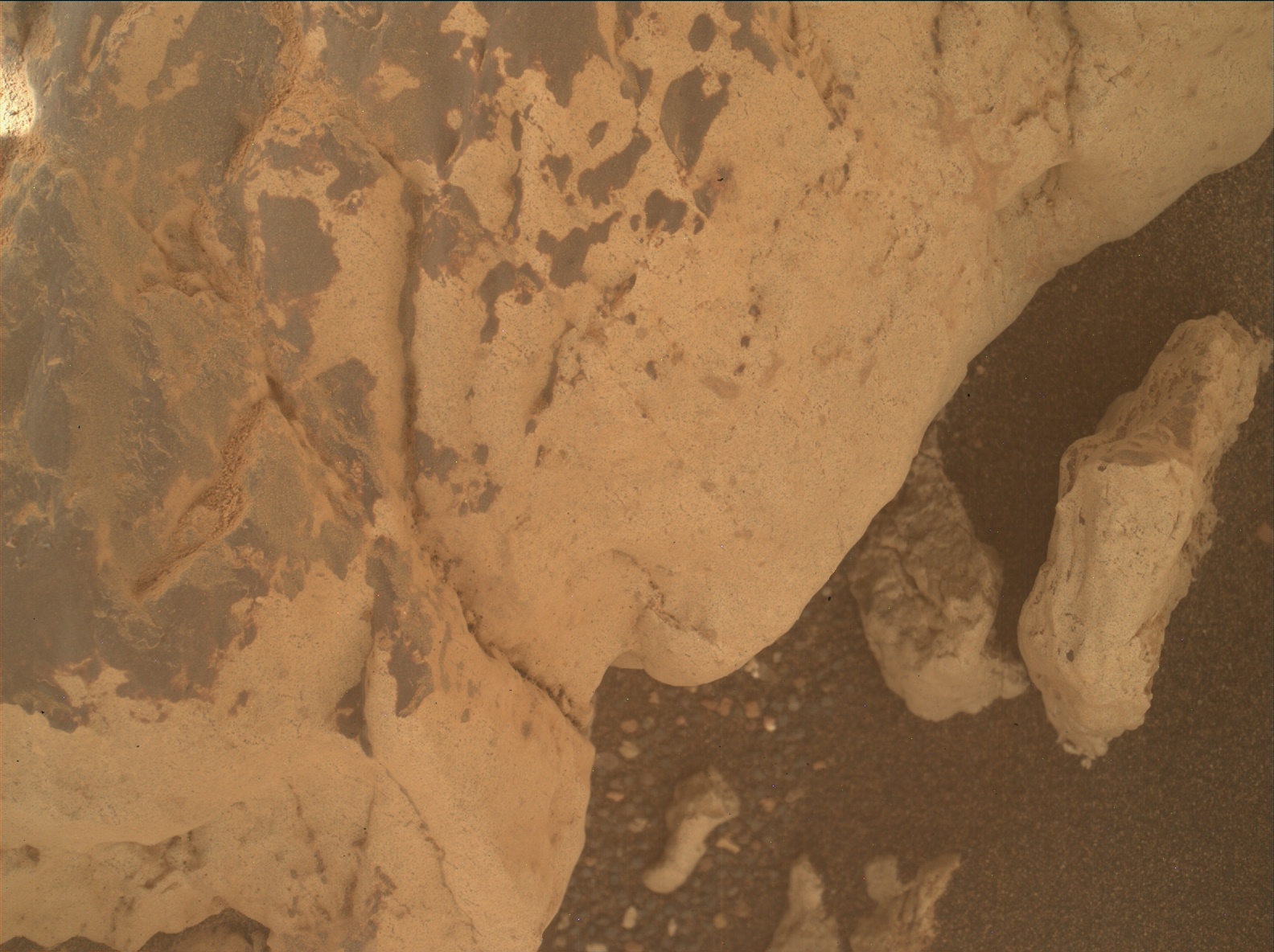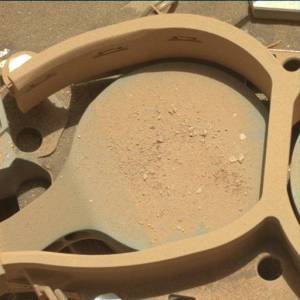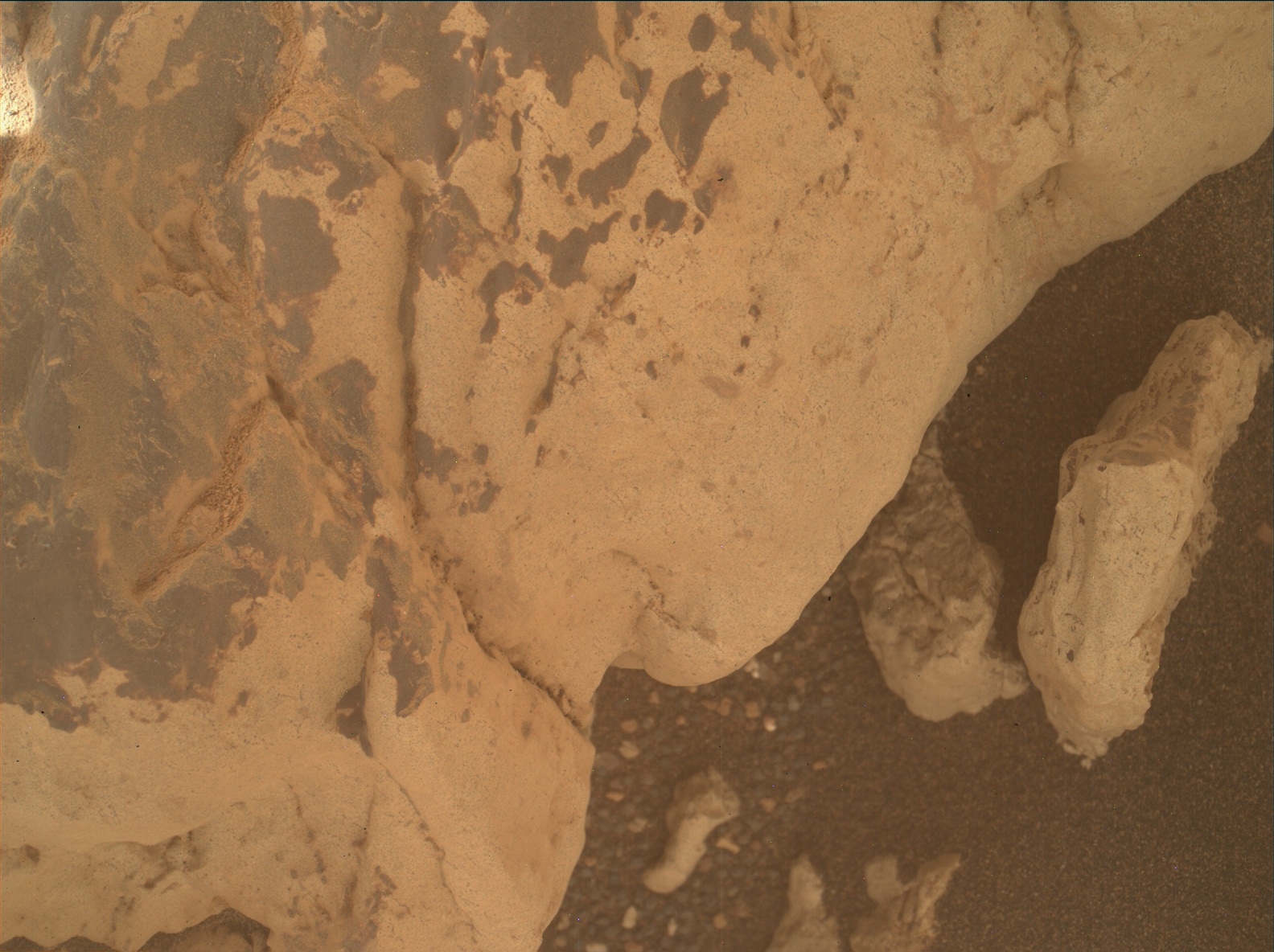Curiosity Navigation Curiosity Home Mission Overview Where is Curiosity? Mission Updates Science Overview Instruments Highlights Exploration Goals News and Features Multimedia Curiosity Raw Images Images Videos Audio More Resources Mars Missions Mars Sample Return Mars Perseverance Rover Mars Curiosity Rover MAVEN Mars Reconnaissance Orbiter Mars Odyssey More Mars Missions The Solar System The Sun Mercury Venus Earth The Moon Mars Jupiter Saturn Uranus Neptune Pluto & Dwarf Planets Asteroids, Comets & Meteors The Kuiper Belt The Oort Cloud 2 min read
Sols 4270-4272: Sample for SAM  An image of “Discovery Pinnacle,” a target of the NASA Mars rover Curiosity’s APXS (Alpha Particle X-Ray Spectrometer), taken from about 5 centimeters (about 2 inches) above. Curiosity used the Mars Hand Lens Imager (MAHLI), located on the turret at the end of the rover’s robotic arm, to capture two to eight images of the target, then used an onboard focusing system to merge those into one image, on sol 4253 — Martian day 4,253 of the Mars Science Laboratory mission — July 24, 2024, at 03:10:00 (UTC). NASA/JPL-Caltech/MSSS Earth planning date: Friday, Aug. 9, 2024
An image of “Discovery Pinnacle,” a target of the NASA Mars rover Curiosity’s APXS (Alpha Particle X-Ray Spectrometer), taken from about 5 centimeters (about 2 inches) above. Curiosity used the Mars Hand Lens Imager (MAHLI), located on the turret at the end of the rover’s robotic arm, to capture two to eight images of the target, then used an onboard focusing system to merge those into one image, on sol 4253 — Martian day 4,253 of the Mars Science Laboratory mission — July 24, 2024, at 03:10:00 (UTC). NASA/JPL-Caltech/MSSS Earth planning date: Friday, Aug. 9, 2024
The focus for this three-sol weekend plan is delivering a portion of the Kings Canyon drill sample to SAM for Evolved Gas Analysis (EGA), following on from a successful CheMin analysis. The CheMin and SAM analyses, coupled with APXS and ChemCam analyses, will tell us about the composition and mineralogy of this block within the Gediz Vallis channel deposit. We can compare it to the composition and mineralogy of the intriguing Mammoth Lakes drilled sample at Whitebark Pass, which was near the elemental sulfur blocks, and also within the Gediz Vallis deposit, as well as to the bedrock outside the channel and other previous drilled samples. This will help inform the source(s) of the blocks, which could be derived from higher up on Mount Sharp.
To further characterize the Kings Canyon block and immediate vicinity, we will acquire three ChemCam LIBS analyses. The “Gabbot Pass” target is on the same light-toned rock as the drill target. “New Army Pass” will investigate the edge of the drilled block, which exhibits textural and tonal similarities to an interesting previous APXS target, “Discovery Pinnacle.” Finally, “Bridalveil Falls” is on a freshly broken, bright rock on the edge of the drilled block. Mastcam will provide documentation imaging of the three targets.
Looking further afield, we continue to image the stunning scenery surrounding us from this vantage point. We planned a ChemCam long distance remote imager (LD RMI) mosaic of the Gediz Vallis channel form to the south, and an extension of a Mastcam mosaic of the Milestone Peak area of the deposit. These mosaics will help us to further characterize the Gediz Vallis deposits, and hopefully the processes responsible for their emplacement (e.g., debris flow or rock avalanche). We will also acquire a Mastcam mosaic of the Texoli butte, which represents a cross section of the rock layers that we will eventually drive over when we leave the Gediz Vallis deposit and continue climbing Mount Sharp.
It isn’t just about the rocks though! The environmental and atmospheric science team also have several observations in this plan to monitor changes in the atmosphere. These include Mastcam tau and Navcam line of sight observations, as well as Navcam zenith, suprahorizon and dust devil movies. Standard DAN, RAD and REMS activities round out the plan.
Written by Lucy Thompson, Planetary Geologist at University of New Brunswick
Details Last Updated Aug 12, 2024 Related Terms Blogs
Keep Exploring Discover More Topics From NASA Mars
Mars is the fourth planet from the Sun, and the seventh largest. It’s the only planet we know of inhabited…

Explore this collection of Mars images, videos, resources, PDFs, and toolkits. Discover valuable content designed to inform, educate, and inspire,…

Each robotic explorer sent to the Red Planet has its own unique capabilities driven by science. Many attributes of a…

Mars Exploration: Science Goals
The key to understanding the past, present or future potential for life on Mars can be found in NASA’s four…



 2 min read Sols 4268-4269: Admiring Kings Canyon
2 min read Sols 4268-4269: Admiring Kings Canyon
 3 min read Sols 4266-4267: Happy ‘Landiversary,’ Curiosity
3 min read Sols 4266-4267: Happy ‘Landiversary,’ Curiosity
 3 min read Sols 4263-4265: A Royal Birthday Celebration at Kings Canyon
3 min read Sols 4263-4265: A Royal Birthday Celebration at Kings Canyon
